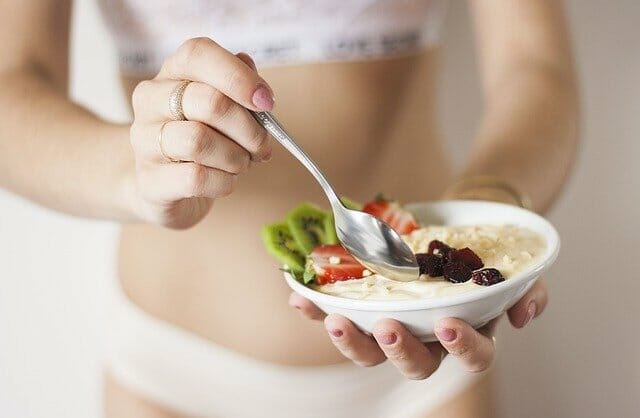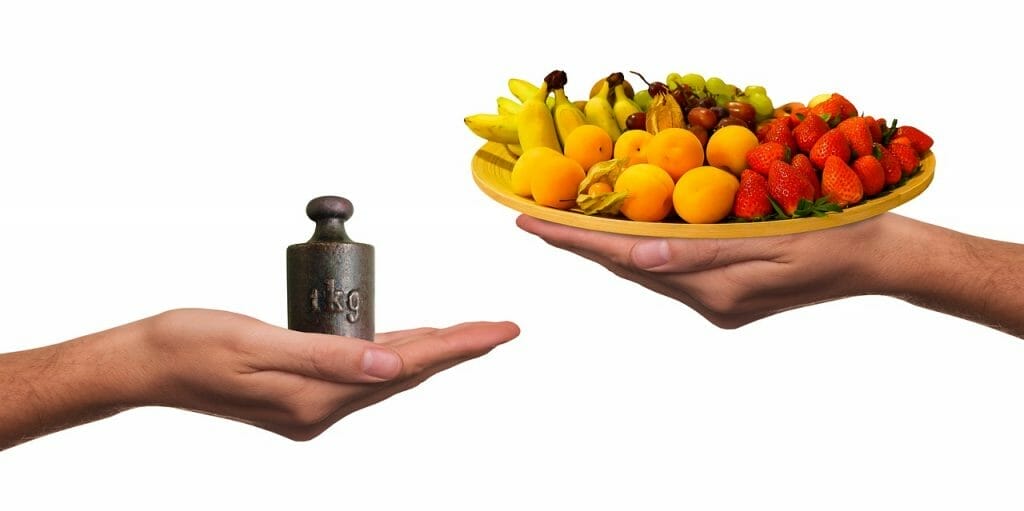Effective weight loss is not only about losing weight quickly and efficiently, but also about maintaining the new body weight permanently. To slim down effectively, you need to redirect your body to actively burn stored fat and block further accumulation of reserves, but without using radical methods that disrupt the natural rhythm of our body. Read the article and find out how to become the owner of a slim, attractive body without having to follow a strict diet and without committing to difficult workouts that you don’t feel like doing!
Table of contents
Overweight is not only an aesthetic problem
Overweight and obesity are one of the most common problems faced by modern society. These are not only problems of aesthetic nature, but also, and perhaps above all, of health nature. Not everyone realizes that by weighing more than our BMI, we increase the risk of many ailments, including some of the most serious diseases.
Here are some of the negative effects of being overweight and obese:
- increased levels of bad cholesterol and triglycerides and increased blood pressure, and consequently an increased risk of hypertension, strokes, strokes, atherosclerosis;
- reduced lung capacity, worse oxygenation of the body, faster fatigue, disrupted body regeneration processes;
- greater burden on the heart, greater risk of heart attack, ischemic disease and other cardiovascular diseases;
- worse work of the joints, greater risk of arthritis, back pain, worsening problems with the musculoskeletal system;
- circulatory problems, damage to blood vessels, leg pain and swelling, varicose veins;
- a significant risk of type 2 diabetes;
- fatty liver, liver and pancreas disorders;
- increased risk of gallbladder disease;
- poorer bowel function, chronic constipation, hemorrhoids;
- faster aging processes;
- disturbances in hormonal economy, menstrual cycle disorders, problems with getting pregnant;
- deterioration of the psychological condition, depression, apathy, anxiety, food addiction (compulsive eating), social isolation, reduced self-esteem.
The list of consequences of overweight and obesity speaks for itself, it clearly shows that the fight against weight is not only a fight for good looks, but first of all for health, longer youth and longer life.
Overweight and obesity – the causes

Excessive weight gain is a consequence of the formation of caloric surpluses in our bodies. They occur when we take in more calories than we are able to burn on a regular basis during everyday life. What is not used as a source of energy for the body, is “pushed” to fat reserves.
The most dangerous for our silhouette are products with a high glycemic index (mainly articles containing large amounts of simple carbohydrates and starch), because they cause rapid fluctuations in blood glucose levels and contribute to the transformation of excess sugars into fat tissue.
So-called processed food, alcohol and fats eaten in excess also do not help the slim figure. On the other hand, the biggest calorie bombs, extremely conducive to weight gain, are products and dishes containing large amounts of simple carbohydrates or starch and fat at the same time (e.g. white pasta or noodles from white flour combined with heavy sauce and fatty meat, cream cakes, chips, fast food).
The most common biological, environmental and psychological causes of overweight and obesity:
- too high daily caloric intake in relation to the body’s needs and at the same time too low level of physical activity;
- poor choice of food (too much food with a high degree of processing, containing large amounts of sugars and fats, providing a lot of excess calories, and not enough natural products, rich in fibre, vitamins, minerals and easily digestible proteins);
- irregular consumption of meals, wrong way of eating (e.g. too fast food, overeating, too few meals a day);
- sedentary lifestyle (working in one position, passive spending of free time, travelling almost exclusively by car, etc.);
- “overeating” stress, negative emotions, problems with self-esteem;
- genetically conditioned tendency to gain excessive weight;
- slow metabolism caused by inborn factors or not very active lifestyle;
- metabolic diseases, hormonal disorders (e.g. hypothyroidism, Cushing’s syndrome, polycystic ovary syndrome, diabetes).
Why is it so difficult to lose weight?
Almost everyone who knows the problem of excess kilograms from autopsy, has had dozens of attempts to lose them. Attempts which, unfortunately, usually end in failure. Why is it so difficult to lose weight? Here are the most common reasons:
1. making too subtle changes to your diet or activity level, ones that don’t really eliminate excess calories or lead to increased fat burning.
For example, replacing white bread with wholemeal bread or cutting down on sweets while ‘making up’ for calories through other fattening products (e.g. ready meals). Another example is trying to introduce physical activity too gently. Half an hour on the exercise bike twice a week or occasional visits to the gym is not enough, especially if we do not cut calories and lead a sedentary lifestyle at the same time. To start burning fat, we should be more active every day.
Making too radical changes to your diet or activity level.
Not only too subtle changes, but also too drastic changes are not an ally for successful weight reduction. Some people think that the best way to lose weight is not to eat. Unfortunately it is quite the opposite, starvation leads to slowing down of metabolism and nutritional deficiencies. When you stop torturing yourself with non-eating, your body will start to store food intensively and you will experience yo-yo effect.
Similarly ineffective in terms of weight loss can be too strenuous workouts, especially if we haven’t done any regular physical activity before and suddenly we start working out at the gym or doing long-distance running. Such physical marathon for the body often ends in exhaustion, injuries, joint strains and leads to exhaustion of enthusiasm and abandonment of a given activity, and thus discontinuation of the slimming treatment. That is why we say no to radical methods!
3. diets that are too hard on the body.
Unfortunately it is a very common practice among people with excess weight. Harsh diets promise fast and intensive weight loss and that’s what attracts like a magnet to people eager for a slim body. Copenhagen diet, 1000 kcal diet, cabbage diet – these are just some of the restrictive diets that, although at first they result in a significant weight loss, a little later they bring the less desirable result, the yo-yo effect.
Overweight comes back because when the diet ends and we go back to eating normally, the body starts to “make up for lost food” and preventively accumulates reserves in the form of fat tissue. Besides, remember that rapid weight loss that can be observed during strict diets is mainly due to water loss from the body, not fat loss. Reducing lipid tissue is a more extended process in time, resulting from a permanent acceleration of metabolism and the introduction of healthy eating habits, not draconian menus.
Lack of consistency in the implementation of the weight loss plan, low motivation.
It often happens, that even though at the beginning we are very enthusiastic about losing weight, fully mobilized and motivated, as time goes by, our will and enthusiasm for further fight for our figure decreases, and then gradually dietetic or training recommendations are eliminated from our life. Why does this happen? Sometimes we lose faith in our own strength and in the fact that we can really lose weight, sometimes we are too impatient – if we don’t see any weight loss for a while, we give up further weight loss, and sometimes we don’t have enough self-denial and willingness to make a real change, to modify the established behavior in terms of nutrition or activity.
5. changing weight-loss diets too often.
Systematic weight loss is not supported by constant implementation of new menus, based on different types of products. Unfortunately we often make this mistake and change diets like the proverbial glove when we are looking for an optimal solution for ourselves. If, for example, we follow an oatmeal diet one week, a protein diet the next, a fruit and vegetable diet the next, and so on, our body will go crazy, and metabolic processes will be disrupted, which translates into difficulties with losing weight. It is better to stick to one well-balanced nutrition plan.
How to slim down effectively? 6 tips leading to a slim figure

A real metamorphosis of the silhouette is connected with permanent change of habits which led to weight gain. This applies to diet, activity, as well as our way of thinking. Working out is just as important as a slimmed down eating style or daily exercise. We need to start thinking fit to be fit.
Here are 6 key psychological, dietary and workout tips that are a prescription for being overweight:
First, change your thinking!
Think of yourself as fit. Imagine yourself as a slim person, think of yourself as a silhouette success, and don’t stray from the path of high motivation to lose weight. Stick to your goals, but don’t look too far ahead. Achieve everything in small steps, don’t be discouraged if in a month you lost less weight than you wanted.
Enjoy every little success, because it is these small successes that make up the final triumph. Remember that you must not give up when moments of doubt come. It’s important to learn to catch negative thoughts and push them away, while reminding yourself of your original figure goals, which are your priority.
Secondly, learn to manage stress and negative emotions!
Stress is part of our day, but that doesn’t mean we have to be slaves to it. For most overweight people, the phenomenon of excessive eating (which often takes the form of consuming uncontrollable amounts of food) is a direct response to nervous tension and lowered mood associated with low self-esteem or personal, professional problems, etc. When we are under stress, our body intensively secretes cortisol. This is a hormone, whose excess causes an increase in blood glucose levels and an increase in appetite. The effect is that we eat more often and more.
There is no doubt that stress, mood swings or negative thoughts flooding us, are extremely interfering with weight loss. If you are also struggling with them, take an interest in various relaxation techniques and start working on your self-esteem and emotions.
Short-term diets bring short-term results. If we want to lose weight effectively, we should start to think differently about food and introduce a new menu permanently. It is worth agreeing internally with yourself that from now on you will make a change and eat differently – healthily and dietetically, but not excessively ascetic.
Your new menu should meet two conditions at the same time: firstly, it should be light, as natural as possible and promote weight loss; secondly, it should give you pleasure from eating. The good news is that dietetic cuisine can be very tasty and simple at the same time. Read the rest of this article to learn how to create such a weight loss-friendly and palate-pleasing menu.
Fourth, modify your eating style!
How to eat to lose weight? Good question. During weight reduction, the way you eat is as important as the content of your meals. The first important point is the right number of meals and not to eat too many portions at one time.
In order to keep your metabolic rate high, eat about 4-6 meals a day, keeping 3- or 4-hour intervals between them. Do not reach for food between meals, but if you suddenly get hungry and there is still some time left before the next meal, you can have something low-calorie (e.g. carrot, celery salad, apple, handful of sunflower seeds) and drink water.
Another thing is to control the size of your meals. How to eat less during meals? First of all, learn to eat slowly and calmly, chewing each bite thoroughly. If you eat quickly, you will consume a lot of calories before you feel satiated. Remember that our mind does not receive the signal that our stomach is full until about 20 minutes after we start eating. A good method is to put smaller, not too large portions on your plate and consume them slowly for about 20 minutes.
It is also worth mentioning a common habit that is certainly not conducive to calorie restriction, i.e. the use of side dishes. Try not to use them, and if you do, reach for an extra portion of what threatens your weight the least – e.g. salad, lettuce, cooked vegetables. Drinking 1 or 2 glasses of water just before a meal is also an effective way to limit calorie intake – this way you will partially fill your stomach, satisfy the first hunger and eat less during the meal itself.

What to eat to be fit? Remember that to trigger fat burning, you need to take in fewer calories than you consume. On the other hand, you cannot slim down your menu too drastically, because your body will switch to economy mode and your metabolism will slow down. The safest way is to reduce your daily calorie intake by 300-500 calories in relation to your daily needs.
For example, if our daily caloric needs are 2000, we try to eat about 1600 kcal per day. Here a question may arise – how do I actually know what my caloric needs are? To calculate it easily, you can use special calculators available on many websites on dietetics and weight loss.
In your new, slimmed down menu there will certainly be no place for traditional dinners based on potatoes, fatty meats, heavy sauces, no place for popular and loved fresh rolls made of white flour, fast food, sweets and snacks that are calorie bombs (such as crisps or cream cakes), sweet drinks, ready-made meals and other products and dishes saturated with fattening ingredients.
Menu should be light, not too caloric, saturated with natural products (rich in valuable nutrients, such as protein or vitamins and minerals), abundant in colorful vegetables and fruits, and at the same time varied, interesting, not devoid of distinctive flavors and aromas.
7 product categories that are the foundation of an effective weight loss diet:
- all vegetables (e.g. tomatoes, beets, carrots, broccoli, spinach, lettuce, kale, peppers, zucchini, turnips, kohlrabi, cabbage, celery and many, many others);
- whole grain products: brown rice, wholemeal pasta, wholemeal bread, coarse groats, cereals, bran, germ;
- legumes (e.g. beans, lentils, chick peas, peas);
- Lean dairy products (e.g. cottage cheese, buttermilk, yoghurt);
- fish (e.g. cod, hake, salmon) and the leanest meats (e.g. chicken and turkey breast, ham and pork tenderloin, beef tenderloin, skinless duck breast)
- eggs;
- fruits, especially those with lower sugar content (e.g. grapefruit, oranges, lemons, apples, peaches, currants, blueberries, raspberries, cherries, plums, strawberries, gooseberries, blackberries, avocados).
Your diet kitchen should also include fresh and dried herbs (e.g. oregano, basil, parsley, coriander, chives) and spices, many of which are thermogenics that enhance fat burning (e.g. ginger, chili pepper, turmeric, cardamom, cinnamon, curry, pepper).
Importantly, don’t limit carbohydrates or fats to zero. They are necessary too! Excess carbohydrates are the most dangerous for your silhouette, however some amount of them (especially complex carbohydrates) is necessary for proper brain functioning or maintaining proper energy level. As for fats, however, consume them in moderation, using mainly those lipids which are more beneficial for your health, i.e. those rich in omega 3 and 6 unsaturated fatty acids (they are present in nuts, grains, olive oil and other vegetable oils).
An example of a slimming menu:
- breakfast: omelette with bran, smoked cottage cheese, tomatoes, peppers and chives
- 2 breakfast: 2 toasts from wholemeal bread with peanut butter
- Dinner: cauliflower soup with natural yoghurt, oven-baked hake, grits, celery salad
- Snack: jelly with fruit
- Dinner: hot lean poultry sausages, tomato or yoghurt-herb dressing, slices of pumpernickel
or
- breakfast: graham with lentil and olive paste, tomato and 2 cucumbers (or half a long cucumber)
- 2 breakfast: diet salad with chicken, brown rice and vegetables
- Lunch: zucchini cream soup, roasted yam stuffed with spinach and feta cheese
- Snack: cocktail of buttermilk and fruit, 2 carrots
- Dinner: wholemeal bread sandwiches with avocado paste, hard boiled egg and radishes
With simple products, which accompany us every day, it is possible to create a whole lot of dietetic dishes. Here are some ideas that are worth using. You can also modify them in many ways, replacing ingredients with related ones and adding new ones, thus avoiding culinary monotony.
Dietary breakfasts:
- milky millet with bananas, raspberries, almonds and sunflower seeds
- Buckwheat with coconut milk, peaches, kiwi and walnuts
- Oatmeal with yoghurt, pears and cinnamon
- Wholemeal tortillas with hard-boiled egg, chive and avocado paste
- wholemeal toast with hummus, cottage cheese with dill, cucumber and radishes
- spelt flour banana pancakes served with honey or fruit
Dietetic dinners:
- pearl barley cassotto with courgettes, peppers and green beans
- risotto with leeks, garlic and mushrooms (dried wild mushrooms or champignons)
- cream of pumpkin soup, second course cutlets of barley groats and carrots served with herbal yoghurt dip and Chinese cabbage salad
- broccoli soup, second course roast turkey breast fillet, roast vegetables, brown rice
- stuffed peppers (stuffing ingredients: minced poultry meat, barley or buckwheat groats, parsley, onion, garlic, mushrooms, tomato concentrate, mozzarella cheese, oregano, chili pepper, salt)
- fish cutlets (made from cod, pollock or hake minced in a blender or meat grinder) breaded in linseed, bulgur groats with vegetables
Dietary suppers:
- salad with smoked salmon, cottage cheese, dill, kale or green lettuce and cherry tomatoes
- diet chicken and mushroom stew, 2 slices of whole grain bread
- oven-fried pumpkin pancakes served with a vegetable medley
- whole grain tortillas with chicken, fresh spinach, olives, cucumber, tomato and bell pepper with garlic yoghurt dip
- lentil cream soup sprinkled with pumpkin seeds, wholemeal toast with mozzarella cheese
- omelette with oatmeal, broccoli and cabbage
Diet cooking is a key point in the plan of switching the body to intensive fat burning mode. Another one is the change of lifestyle to a more active one. It’s worth stressing that movement is important not only from the point of view of body shaping, but also taking care of health. Strengthened immunity, lower risk of cardiovascular diseases and diabetes, better condition of bones and muscles, reduced stress, improved mood, better mental performance – these are only some of the many benefits that regular physical activity brings us.
Sixth, be vital, be active!
Do you want to start seeing real changes in your silhouette? Start moving more! Systematic activity is a brilliant way to permanently raise your metabolic rate and speed up weight loss. The higher the level of activity, the more energy our body uses and the more often it reaches stored fat reserves.
A good patent for an effective and permanent acceleration of metabolism is a cyclic, short (about 25-30 minutes), but intense interval or strength training. Due to the intensive effort that accompanies interval and strength training, very high energy expenditure occurs. What’s more, the body uses the increased energy also many hours after such a workout. Throughout this time we are dealing with the increased burning of calories from food and the increased breakdown of fat tissue.
However, not everyone is prepared for intensive training. People who are more overweight and in poorer physical condition should start with milder forms of activity. You don’t have to exercise hard to start losing weight effectively. You can bet on moderate aerobic training, organized classes (e.g. zumba, aerobics, team sports), you can swim, dance, or even go for dynamic, long walks. The most important thing is to do it systematically, preferably several times a week, and combine movement with diet, as mentioned above.
Do you have no energy and enthusiasm for activity? Check the current ranking of fat burners which simultaneously give you energy, block your appetite and stimulate the breakdown of fat tissue!


